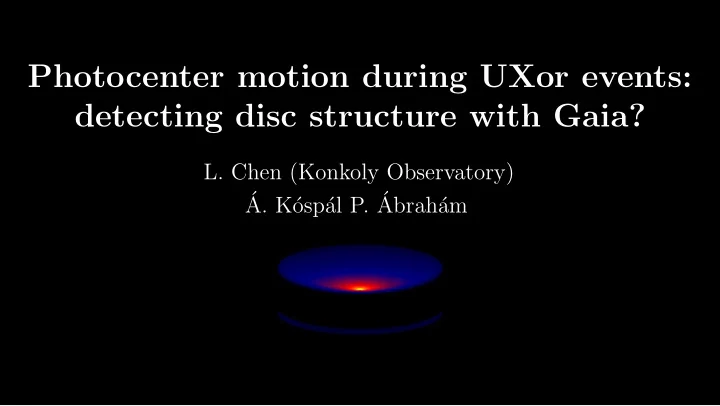

Photocenter motion during UXor events: detecting disc structure with Gaia? L. Chen (Konkoly Observatory) ´ al P. ´ A. K´ osp´ Abrah´ am
UXOR: (sporadically obscured) star + inclined disc • Gaia measures photocenter of the sys- tem (T. Prusti’s talk) • Typically not coincident with the star (scattered light asymmetric) • The displacement is related to the disc structure. • An obscuring event will enhance the displacement. Breaking news: Dodin, ..., Lamzin, ..., Safonov, ...,2019: Detected photocentre motion in scattered light of RW Aur
General principle (For a system with a unresolved spatial distribution) • Astrometry measures the centre of the brightness distribution (photocentre). • Not the centre of mass (barycentre). Apparent motion includes: • Proper motion (barycentre) • Motion of photocentre w.r.t barycentre • Parallax A standard five-parameter solution includes only proper motion and parallax.
An example of photocenter motion: “variability-induced movers” (Wielens 1996).
“Variability-induced movers” (Wie- lens 1996). Could be used to • detect binary (using high- precision astrometry) • set constraints on binary pa- rameters.
VIMs in HIPPARCUS (Bertout+ 1999) • detect 8 binary (as VIM) • set constraints on binary pa- rameters.
Reference model • L ∗ = 5 L ⊙ • R = [0 . 2 , 100] au • h in = 0 . 05 • h out = 0 . 1 • inclination: 70 ◦ Photocentre lies at north of the star, by 0 . 3 au. Moves to 4 . 3 au from the star if the star light is blocked.
5 4 position ( au ) 3 2 1 B V R 0 0 2 4 6 8 A V For eclipse of moderate depth, there is a wavelength-dependent displacement.
0 1 2 ∆ mag 3 4 B V R 5 0 2 4 6 8 A V
5 4 position ( au ) 3 2 1 B V R 0 5 4 3 2 1 0 ∆ mag
Why should we care? • ∼ 10 mas of angular shift. • A “noise” in astrometric measurement. Parallax! (T. Prusti’s talk: UXORs tends to have bad parallax measurements.) • Information about disc • Identifying UXOR events. • Verifying UXOR theory.
4 Maximum shift ( au ) 3 2 1 0 0 20 40 60 Inclination (degree)
8 6 Maximum shift ( au ) 4 2 0 0 50 100 150 200 Disk size [au]
4 Maximum shift ( au ) 3 2 1 0 0 0.02 0.04 0.06 0.08 0.1 Outer scale height
Motion ↔ Disk structure • Amplitude ↔ Disk size, inclination, flaring... • Position angle ↔ PA of disk. (com- pare with other measurement)
VIMs in HIPPARCUS (Bertout+ 1999) • Some UXORs have VIM effects. • UX Ori: PA ∼ 257 ◦ • Disk major axis: PA ∼ 130 − − 150 ◦ (Kreplin+ 2016) • UX Ori in Gaia? (binary or not)
Question: • Taken into account in astrometric mod- elling (better parallax, proper motion)? Thanks! • Studying UXOR with: Gaia time series of photometry+astrometry? • Considered in Gaia alert? • With Gaia DR2, how to check whether a give star might have additional motion on top of proper motion and parallax (bad fitting with 5-parameter model)?
Recommend
More recommend